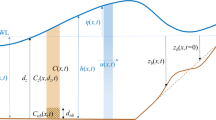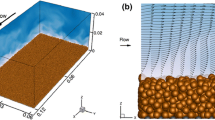Abstract
This paper aims at addressing issues related to the misrepresentation of the turbulent stratified flow for sand wave simulation using the continuum coupled flow and morphodynamics modeling approach. continuum flow and morphodynamics frameworks often consider the contributions of (i) suspended sediment-load in the sediment mass-balance equation and (ii) stratification in the equations of fluid motion. We argue that omitting these contributions could impact the numerical simulation results of transverse sand wave development at the late stages of bed evolution. We support our argument by presenting a numerical analysis, which attempts to quantify the impact of the stratification and suspended sediment-load on the calculated bed topography during various stages of transverse sand wave evolution in a mobile bed flume.




Similar content being viewed by others
References
Venditti JG, Church MA (2005) Bed form initiation from a flat sand bed. J Geophys Res Earth Surf 110:F01009
Venditti JG, Church MA, Bennett SJ (2005) Morphodynamics of small-scale superimposed sand waves over migrating dune bed forms. Water Resour Res 41:W10423
Venditti JG, Church MA, Bennett SJ (2006) On interfacial instability as a cause of transverse subcritical bed forms. Water Resour Res 42:W07423
Hino M (1968) Equilibrium-range spectra of sand waves formed by flowing water. J Fluid Mech 34:565–573
Hansen J, van Hecke M, Haaning A, Ellegaard C, Anderson K, Bohr T, Sams T (2001) Pattern formation: instabilities in sand ripples. Nature 410:324
Raudkivi AJ (2007) Transition from ripples to dunes. J Hydraul Eng 132:1316–1320
Mazumder B, Pal D, Ghoshal K, Ojha S (2009) Turbulence statistics of flow over isolated scalene and isosceles triangular-shaped bed forms. J Hydraul Res 47(5):626–637
Dreano J, Valance A, Lague D, Cassar C (2010) Experimental study on transient and steady-state dynamics of bedforms in supply limited configuration. Earth Surf Process Landf 35(14):1730–1743
Sarkar S, Dey S (2010) Double-averaging turbulence characteristics in flows over a gravel-bed. J Hydraul Res 48:801–809
Andereotti B, Claudin P, Devauchelle O, Duran O, Fourriere A (2011) Bedforms in a turbulent stream: ripples, chevrons and antidunes. J Fluid Mech 690:94–128
Niemann SL, Fredsoe J, Jacobsen NG (2011) Sand dunes in steady flow at low Froude numbers: dune height evolution and flow resistance. J Hydraul Eng 137(1):5–14
Charru F, Andereotti B, Claudin P (2013) Sand ripples and dunes. Annu Rev Fluid Mech 45:469–493
Best J, Kostaschuk RA (2002) An experimental study of turbulent flow over a low-angle dune. J Geophys Res 107(C9):3135
Fredsoe J (1974) On the development of dunes in erodible channels. J Fluid Mech 60:1–16
Richards KJ (1980) The formation of ripples and dunes on an erodible bed. J Fluid Mech 99:597–618
Coleman SE, Nikora VI, McLean SR, Clunie TM, Schlicke T, Melville BW (2006) Equilibrium hydrodynamics concept for developing dunes. Phys Fluids 18:105104
Colombini RM (2004) Revisiting the linear theory of sand dune formation. J Fluid Mech 502:1–16
Colombini M, Stocchino A (2012) Three-dimensional river bed forms. J Fluid Mech 695:63–80
Coleman SE, Fenton JD (2000) Potential-flow instability theory and alluvial stream bed forms. J Fluid Mech 418:101–117
De Moraes FE (2013) Three-dimensional sand ripples as the product of vortex instability. Appl Math Model 37:3193–3199
Zedler EA, Street RL (2001) Large-eddy simulation of sediment transport: currents over ripples. J Hydraul Eng 127(6):444–452
Scandura PG, Vittori G, Blondeaux P (2000) Three-dimensional oscillatory flow over steep ripples. J Fluid Mech 412:335–378
Chang YS, Scotti A (2004) Modeling unsteady turbulent flows over ripples: Reynolds-averaged Navier–Stokes equations (RANS) versus large-eddy simulation (LES). J Geophys Res 109:C09012
Barr BC, Slinn D, Piero T, Winters K (2004) Numerical simulation of turbulent, oscillatory flow over sand ripples. J Geophys Res 109:C09009
Best J (2005) The fluid dynamics of river dunes: a review and some future research directions. J Geophys Res 119:1–21
Yue W, Lin CL, Patel VC (2005) Coherent structures in open-channel flows over a fixed dune. Trans ASME J Fluids Eng 127(5):858–864
Zou LY, Liu NS, Lu XY (2006) An investigation of pulsating turbulent open channel flow by large eddy simulation. Comput Fluids 35(1):74–102
Chau L, Bhaganagar K (2012) Understanding turbulent flow over ripple-shaped random roughness in a channel. Phys Fluids 24:115102
Omidyeganeh M, Piomelli U (2013) Large-eddy simulation of three-dimensional dunes in a steady, unidirectional flow. Part 1. Turbulence statistics. J Fluid Mech 721:454–483
Omidyeganeh M, Piomelli U (2013) Large-eddy simulation of three-dimensional dunes in a steady, unidirectional flow. Part 2. Flow structures. J Fluid Mech 734:509–534
Khosronejad A, Sotiropoulos F (2014) Numerical simulation of sand waves in a turbulent open channel flow. J Fluid Mech 753:150–216
Liu Y, Fang H, Huang L, He C (2019) Numerical simulation of the production of three-dimensional sediment dunes. Phys Fluids 31:096603
Khosronejad A, Kozarek J, Palmsten ML, Sotiropoulos F (2015) Numerical simulation of large dunes in meandering streams and rivers with in-stream structures. Adv Water Resour 81:45–61
Sotiropoulos F, Khosronejad A (2016) Sand waves in environmental flows: Insights gained by coupling large-eddy simulation with morphodynamics. Phys Fluids 28(2):021301
Chou YJ, Fringer OB (2008) Modeling dilute sediment suspension using large-eddy simulation with a dynamic mixed model. Phys Fluids 20:115103
Roulund A, Sumer BM, Fredsoe J, Michelsen J (2005) Numerical and experimental investigation of flow and scour around a circular pile. J Fluid Mech 534:351–401
Escauriaza C, Sotiropoulos F (2011) Initial stages of erosion and bed-form development in turbulent flow past a bridge pier. J Geophys Res 116:F03007
Chou YJ, Fringer OB (2010) A model for the simulation of coupled flow-bed form evolution in turbulent flows. J Geophys Res Earth Surf 115:C10041
Tjerry S, Fredsoe J (2005) Calculation of dune morphology. J Geophys Res 110:F04013
Zedler EA, Street RL (2006) Sediment transport over ripples in oscillatory flow. J Hydraul Eng 132(2):1–14
Chang YS, Scotti A (2003) Entrainment and suspension of sediments into a turbulent flow over ripples. J Turbul 4(19):1–22
Nabi M, De Vriend HJ, Mosselman E, Sloff J, Shimizu Y (2012) Detailed simulation of morphodynamics: 1. Hydrodynamic model. Water Resour Res 48:W12523
Giri S, Shimizu Y (2006) Numerical computation of sand dune migration with free surface. Water Resour Res 42(10):W10422
Giri S, Shimizu Y (2007) Validation of a numerical model for flow and bedform dynamics. Annu J Hydraul Eng Jpn Soc Civ Eng 51:139–144
Escauriaza C, Sotiropoulos F (2011) Lagrangian dynamics of bedload transport in turbulent junction flows. J Fluid Mech 666:36–76
Mazzuoli M, Kidanemariam AG, Uhlmann M (2019) Direct numerical simulations of ripples in an oscillatory flow. J Fluid Mech 863:572–600
Kidanemariam AG, Uhlmann M (2014) Direct numerical simulation of pattern formation in subaqueous sediment. J Fluid Mech 750:1–13
Van Rijn LC (1993) Principles of sediment transport in rivers, estuaries, and coastal seas. Aqua Publications, Blokzijl
Kuerten JG (2016) Point-particle DNS and LES of particle-laden turbulent flow-a state-of-the-art review. Flow Turbul Combust 97(3):689–713
Zhao L, Challabotla NR, Andersson HI, Variano EA (2015) Rotation of nonspherical particles in turbulent channel flow. Phys Rev Lett 115(24):244501
Challabotla NR, Zhao LH, Andersson HI (2015) Shape effects on dynamics of inertia-free spheroids in wall turbulence. Phys Fluids 27(6):061703
Khosronejad A, Sotiropoulos F (2017) On the genesis and evolution of barchan dunes: morphodynamics. J Fluid Mech 815:117–148
Germano M, Piomellim U, Moin P, Cabot WH (1991) A dynamic subgrid-scale eddy viscosity model. Phys Fluids A 3(7):1760–1765
Khosronejad A, Sotiropoulos F (2018) Reply to comment by Sookhak Lari, K. and Davis, G. B. on ‘Large eddy simulation of turbulence and solute transport in a forested headwater stream’: Invalid representation of scalar transport by the act of diffusion. J Geophys Res Earth Surf 123:1610–1612
Apsley DD, Stansby PK (2008) Bed-load sediment transport on large slopes: model formulation and implementation within a RANS solver. J Hydraul Eng 134(10):1440–1451
Khosronejad A, Flora K, Kang S (2020) Effect of inlet turbulent boundary conditions on scour predictions of coupled LES and morphodynamics in a field-scale river: bankfull flow conditions. J Hydraul Eng 146(4):04020020
Van Rijn LC (1981) Entrainment of fine sediment particles: development of concentration profiles in a steady, uniform flow without initial sediment load. Report No. M1531, Part II, Delft Hudraulic Laboraory, The Netherlands
Acknowledgements
This work was supported by the NSF Award EAR-1823121.
Author information
Authors and Affiliations
Corresponding author
Additional information
Publisher's Note
Springer Nature remains neutral with regard to jurisdictional claims in published maps and institutional affiliations.
Appendix: Model validation for net entrainment of sediment from the mobile bed
Appendix: Model validation for net entrainment of sediment from the mobile bed
We used the experimental data of Van Rijn [57] to validate the model for net entrainment from a mobile bed. The experiment test was done in a 0.5 m wide and 10 m long mobile-bed flume with a mean-flow depth of 0.25 m, and a mean-flow velocity of 0.47 m/s. The flume’s bottom was covered with sand material with a median grain size of 1.45 mm. The incoming water into the flume has a base sediment concentration of zero. The turbulent flow over the mobile bed leads to the entrainment of sediment material into the suspension. The test case was simulated by considering 5 m of the experimental flume using a grid resolution of 0.008 m, 0.005 m, and 0.003 m in streamwise, spanwise, and vertical directions, respectively. The turbulent Schmitt number considered in the calculations was set equal to 0.5.
The simulation was run until the sediment concertation profiles throughout the flume reached equilibrium. Once at equilibrium, the concentration field was time-averaged for one flow-through time of the flow domain. Then, the vertical profiles of the time-averaged sediment concentration were taken from the centerline of the channel were compared with the measured values at three different locations downstream of the inlet. In Fig.
Measured (circles) and computed (dashed lines) sediment concentrations (C) profiles in the water column under net entrainment from mobile bed in the experiment of Van Rijn [57]. The sediment concentration profiles are probed at the centerline of the flume, at distances equal to 1.0 m (a), 2.5 m (b), and 5.0 m (c) downstream of the inlet of the flume. The sediment concentration (C) is in volume fraction, and the vertical distance from the mobile bed (z) is non-dimensionalized with the mean-flow depth of 0.25 m
5, we present the comparisons between the measured and calculated sediment concentrations.
Rights and permissions
About this article
Cite this article
Khosronejad, A., Sotiropoulos, F. A short note on the simulation of turbulent stratified flow and mobile bed interaction using the continuum coupled flow and morphodynamics model. Environ Fluid Mech 20, 1511–1525 (2020). https://doi.org/10.1007/s10652-020-09752-8
Received:
Accepted:
Published:
Issue Date:
DOI: https://doi.org/10.1007/s10652-020-09752-8





